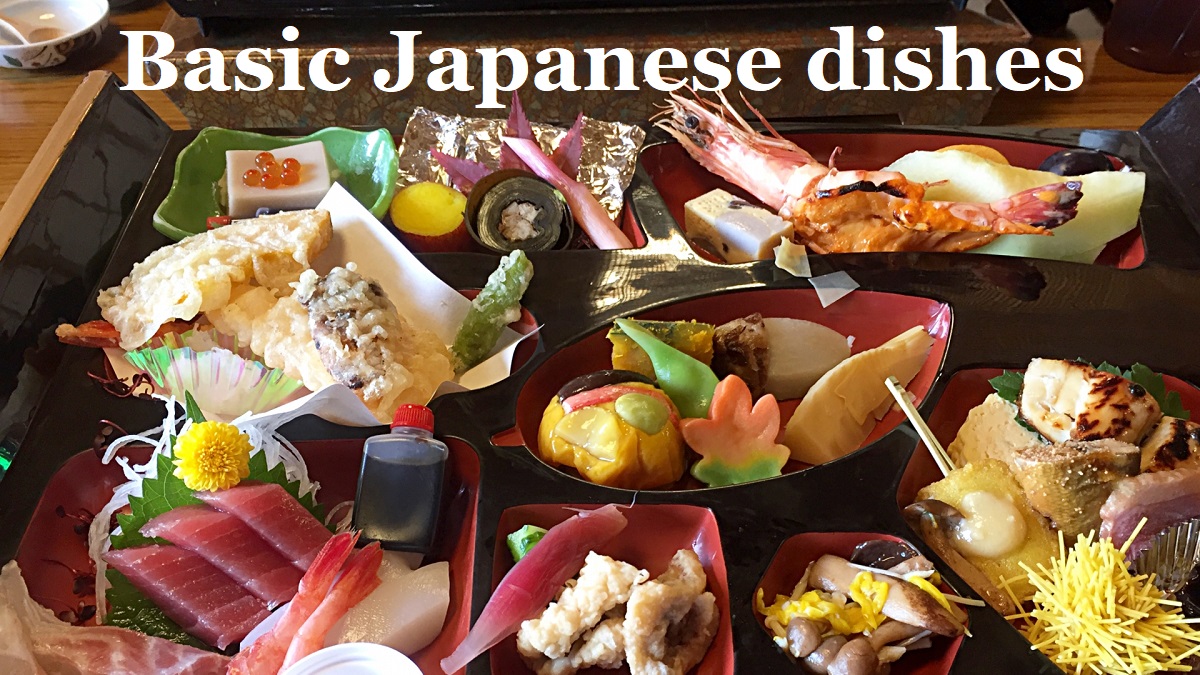Basic Japanese dishes
Sashimi
Sashimi is sliced raw fish, and it is the star of Japanese cooking.
It is certainly served at the dinner of ryokan, hotel or minshuku, and we can find it as one of main dishes at most Japanese pubs.
You may think that Japanese people eat raw fish with fishy odor in whole.
But it is not right.
For sashimi, the parts of tasty flesh of a fresh fish are carved out, and it is sliced finely.
And it is beautiflully arranged on a plate.
We can hardly sense fishy smell, and the color of fresh fish is beautiful.
In addition, you may be worried about parasite of raw fish.
But Japanese people have eaten raw fish since ancient times and the hygiene management of fish has been kept a high level.
And, when eating sashimi, wasabi as a spice and shoyu as a sauce have sterilizing effects.
That is the wisdom of ancestors for eating raw fish.
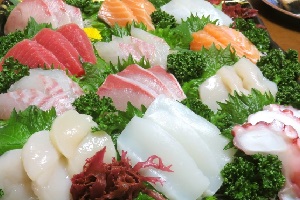
Various Sashimi
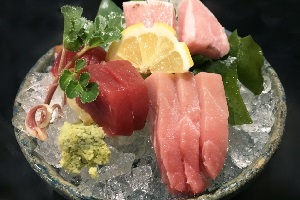
Sashimi of Maguro (Akami & Toro)
Maguro (tuna) is the most popular ingredient of sashimi.
Bright red flesh is called "akami", and it is the common-served part of maguro.
Sometimes, pink and marbled flesh are served.
It is called "toro" and is most fatty part of maguro. It is expensive.
They are never fishy, and we feel slightly sweet.
Many kinds of fish are eaten as sashimi.
We often find buri (alias name is "hamachi", Japanese amberjack), tai (red seabream), hirame (olive flounder), ika (squid), ebi (shrimp), uni (sea urchin), hotate-gai (Japanese scallop) and so on.
Of course, other kinds of fish are found at each season and country.
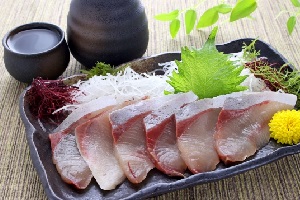
Sashimi of Buri
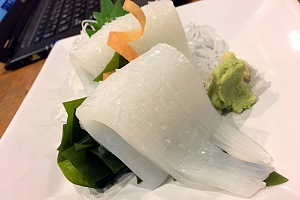
Sashimi of Ika
Grated wasabi is used as the spice when we eat sashimi.
We dip in shoyu and eat with grated wasabi.
Wasabi is Japanese horseradish.
Grated wasabi has light green color, and is the spice to irritate to the nose.
So you should put little wasabi on a piece of sashimi.
Or, mixing moderate amounts of wasabi to shoyu is one of the method to eat sashimi.
In many cases, a lump of grated wasabi is put on a side of sashimi dish.
Some ryokans or restaurants give a raw wasabi and a grater to the guest, and the guest grates it according to his/her taste.
It is the consideration to the guest to enjoy the fresh flavor of wasabi.
(Wasabi is a delicate plant, so standard home uses the processed product.)
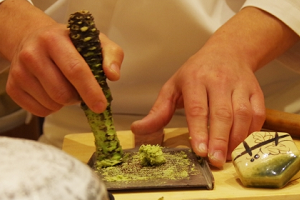
Chef is grating Wasabi
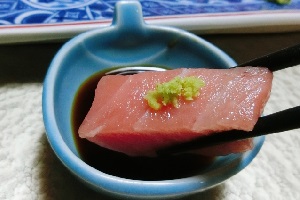
Sashimi dipped in shoyu with wasabi
On the other hand, when the sashimi of fugu (pufferfish), ponzu (shoyu and vinegar) is served instead of shoyu and wasabi.
By the way, finely-filamented raw daikon (Japanese radish) and ooba leaf (Green perilla) are placed on the plate, and the pieces of sashimi are decorated on or by them.
They are called "tsuma" and serve as a foil to sashimi.
But, of course, because they are raw vegetable, you can eat them.
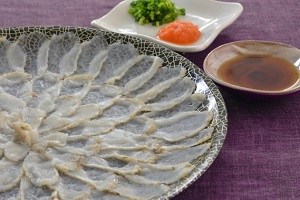
Sashimi of Fugu and ponzu
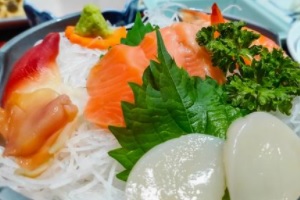
Sashimi on tsuma
Simmered dishes (Nimono)
Some ingredients are put in the soup of dashi, shoyu and mirin, and are boiled. And, Sugar is sometimes added.
The ingredients absorbing the tasty soup become soft, and the taste is salty-sweet.
Various vegetables (mainly root vegetables), fish, meat and other foods are used.
But the method of cooking is simple.
It is called as Nimono in Japanese.
So this is traditional home cooking.
Because various ingredients are used, the combinations of ingredients are without number.
The followings are some of the popular dishes.
Nikujaga
Nikujaga means "meat and potato".
It is the dish that sliced beef, potato and onion are boiled in the soup of dashi, shoyu and mirin.
It was first made by chefs of the Imperial Japanese Navy in the late of 19th.
Certainly, the ingredients are mainly used for western style dish.
But the taste is Japanese style, and it is one of most beloved dishes now in Japan.
Simmered dish of Hijiki
It is a typical simmered dish of one ingredient.
Of course, main ingredient is Hijiki (Black seaweed) and a few foods are cooked with it.
Generally, chopped carrot and Abura-age (Fried thinly-sliced tofu) are added.
They are boiled in the soup of dashi, shoyu and mirin.
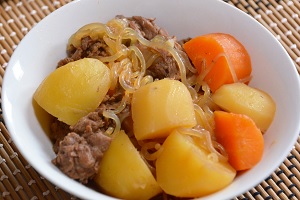
Nikujaga
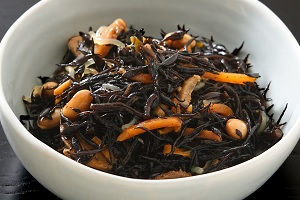
Simmered dish of Hijiki
Oden
Oden is the dish that daikon, kon-nyaku, boiled egg and a lot of foods processed fish are stewed in the soup of dashi and shoyu.
Generally, it is made in large volume in a big pot, and is continued to stew for a long time.
Therefore, you have more chances to eat them at Japanese pubs or stalls rather than home.
And because it is popular in cold season, most convenience stores also sell them in such season.
In most cases, we can order the ingredients of Oden which we want to eat.
Then, the clerk picks up them from a big pot to a plate and served.
Generally, we eat them with Japanese mustard which is yellow and very sharp.
Chikuzen-ni
Rotus root, burdock root, carrot, bamboo shoot, Japanese yam, shiitake mashroom, kon-nyaku and chicken are boiled in the soup of dashi, shoyu and mirin.
Many root vagitables are used and it has a hard texture.
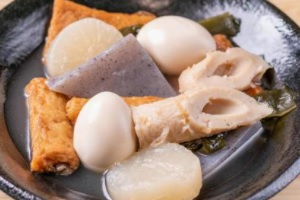
Oden
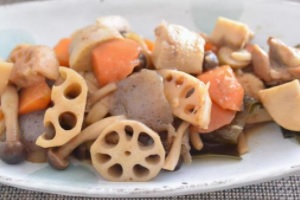
Chikuzen-ni
Saba (Mackerel) simmered in miso
Fish is sometimes used for simmered cooking.
Saba (Mackerel) is simmered in the liquid of miso, sake and suger.
To remove the odor of fish, sliced ginger is added in the liquid.
Kakuni of Pork
It is made of thick cubes of pork belly simmered in dashi, shoyu, mirin, sugar, and sake.
Because the pork is simmered for a long time, it becomes soft and the tasty soup becomes thick.
This dish is influenced by Chinese cuisine.
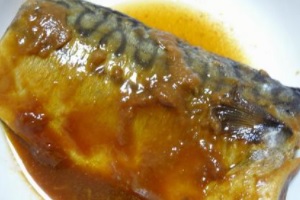
Saba simmered in miso
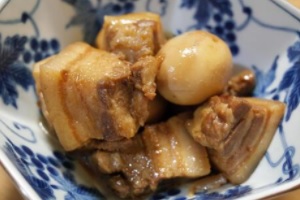
Kakuni of Pork
Grilled dishes (Yakimono)
Originally, there wasn't frying pan as cooking device in Japan.
When they wanted to heated foods, they grilled them over an open fire.
So, many grilled dishes are found in Japanese cooking.
It is called Yakimono in Japanese.
Grilled fish
Salt is sprinkled on a whole fish, then the fish is grilled directly.
The grilled fish has the original feature and is lying on a plate.
Japanese people eat it breaking into flakes with chopsticks and leave only the skeleton.
This is the method to cook for the smaller fish than about 20 centimeters in length.
Sanma (Pacific saury), ayu (freshwater fish), tai (Red seabream), etc. are the popular fish.
Bigger fish are cooked by filleting.
Most fillets are with skin.
Salmon, cod, buri (Japanese amberjack), sawara (Japanese Spanish mackerel) and other many fish are popular.
Of course, at home, fish roaster or frying pan is usually used for this cooking.
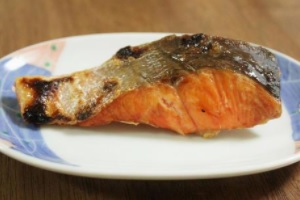
Broiled Salmon
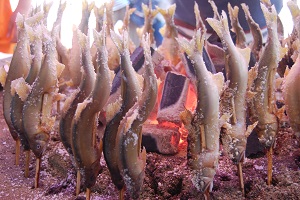
Broiling Ayu
Teriyaki
Teriyaki is a word of cooking technique.
Ingredient is grilled with brushing with the sauce of shoyu mixed with sweet mirin or sugar.
The sugar in the sauce gives the ingredient luster and viscosity with the brown color of shoyu.
The condition is called "teri" in Japanese.
"Teriyaki" sauce seems to be sold even overseas, but most of them are different from Japanese original "teriyaki" sauce because of different ingredients.
Most popular ingredient is chicken and fish.
Buri (Japanese amberjack) is the most popular fish for the cooking.
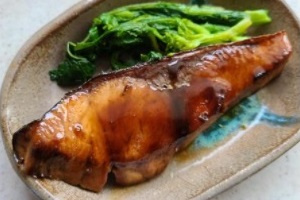
Teriyaki of Buri
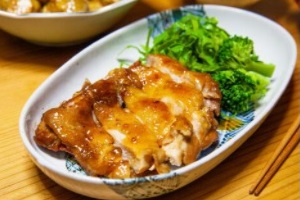
Teriyaki of Chicken
Yakitori
Yakitori is a Japanese type of skewered chicken.
Some bite-sized pieces of chicken meat or offal are skewered, then they are grilled.
Commonly, we have a choice of seasonings either simple salt and pepper or teriyaki sauce every skewer.
Yakitori is most popular dish in Japanese-style pubs.
Kabayaki of eel
Kabayaki is also a word of cooking technique.
Fish is filleted and boned, and it is dipped in sweet shoyu mixed mirin or sugar. Then, it is grilled.
During grilling, the fish is sometimes dipped in the sauce.
The tasty sauce coats the fish sufficiently.
The method of kabayaki is used for the cooking of eel.
The kabayaki of eel is usually served with itself topped on rice.
We can eat it at eel restaurant.
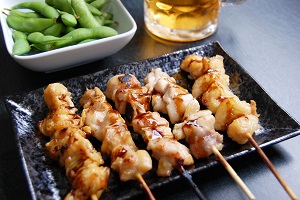
Yakitori
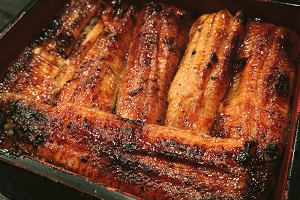
Kabayaki of eel
Steaming dishes (Mushimono)
Steaming is a method of cooking using steam.
The foods are put in a container made of metal or bamboo, and the container is steamed by boiling water continuously.
Mainly, the method is used for steaming glutinous rice, sweet potatoes, etc. including starch.
And when many Japanese confections are made, they have a process for steaming.
But, it is sometimes used for making a few gorgeous dishes.
Chawan-mushi
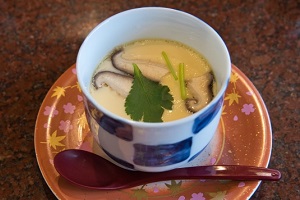
Chawan-mushi
Some pieces of ingredients are put into a small ceramic bowl and the soup of beaten egg and dashi broth are filled in the pot.
After that, the bowl is steamed in a steamer pot.
This is Chawan-mushi, and the hot bowl is served.
Ceramic bowl is "chawan" in Japanese.
The steamed soup including egg is like custard pudding.
As the ingredients, pieces of chicken, shrimp, shiitake (Japanese mashroom), kamaboko (fish cake), etc.
And, ginkgo nuts and edible lily bulb are often added.
Chawan-mushi is like a soup with various ingredients, so it is sometimes served instead of miso-soup or suimono sopu.
Saka-Mushi
Clams such as asari (Japanese littleneck clam) are put into a pan, and Japanese sake is sprinkled on them.
After putting a lid on it, the pan is steamed.
Other shellfish or white fish is also used.
"Saka" is the changed word of "Sake".
Dobin-Mushi
Dobin means tea pot.
Expensive Matsutake mashroom and a few ingredients are boiled in dashi soup for a short time, and they are put in a dobin.
After steaming naturally in the dobin, the tasty soup is eaten enjoying the flavor of Matsutake.
Matsutake is harvested only in autumn and is very expensive.
So this dish is served as a part of gorgeous cuisine in autumn.
By the way, Japanese people like the scent of Matsutake very much, but it seems that most foreign people feel a bad smell.
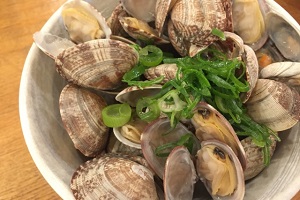
Saka-Mushi of Asari
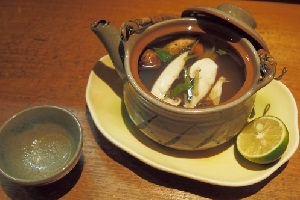
Matsutake Dobin-Mushi
Fried dishes (Agemono)
Japanese dishes are basically cooked without oil.
But there are some exceptional dishes made by frying ingredients in deep oil.
They aren't original Japanese dishes.
Western or Chinese people made their dishes in Japan, and Japanese cooks learned and suited them to Japanese taste.
Probably, that was since the 17th century.
Tenpura
Tenpura is one of the most famous Japanese dishes, and is fried seafoods or vegetables with coating of batter in deep oil.
(It is also written as "Tempura".)
As the ingredients, prawn, eggplant, pumpkin, green pepper, sweet potato, lotus root are popular, but the other various foods are also used for tenpura.
And tenpura of chopped vegitable such as onion, burdock, carrot, etc. mixed in batter is called Kakiage.
Tenpura was introduced by Christian missionaries from Portugal or Spain in the 16th century.
It is said that the food was like fritter at the time.
After that, it had changed to Japanese tenpura today.
A light batter is made of cold water, wheat flour and eggs.
And it takes a certain amount of skill for the cook to make tasty tenpura well.
Generally, it is served with "tentsuyu" (sauce mixed dashi and shoyu) and grated daikon (Japanese radish).
You dip tenpura in the tentsuyu mixed grated daikon and eat.
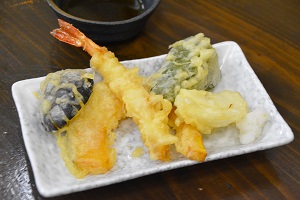
Tenpura
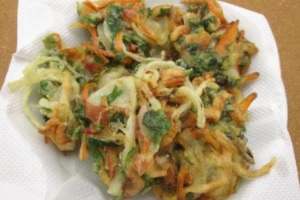
Kakiage
Tonkatsu
Tonkatsu is the Japanese version of western cutlet.
It was invented by a restaurant in Tokyo in 1899.
Veal is mainly used for Western cutlet and it is fried in a fry pan.
Because there was no veal in Japan, pork has been used for Japanese tonkatsu.
"Ton" means pork and "katsu" means cutlet in Japanese.
The cooking method of Tonkatsu is different from western cutlet.
A thick-cut pork fillet ("hire" in Japanese) or pork loin ("rôsu" in Japanese) coated with flour, egg and bread crumbs is fried in deep and low-temperature oil for several minutes.
At tonkatsu restaurant, you can order either "hire-katsu" or "rôsu-katsu".
It is commonly eaten with Japanese Worcestershire sauce for Tonkatsu and often a bit of Japanese mustard.
And a mountain of shredded cabbages are dish up with tonkatsu.
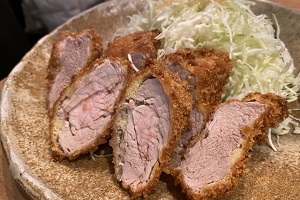
Hire-katsu
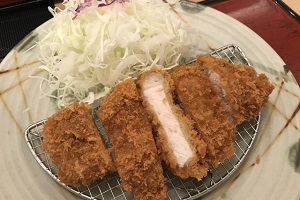
Rosu-katsu
Furai
Furai is the cooking method that seafood coated bread crumbs is fried in deep oil like Tonkatsu.
The name of "furai" comes from "fry" in English.
Most popular ingredients are ebi (prawn), aji (horse mackerel), ika (squid) and kaki (oyster).
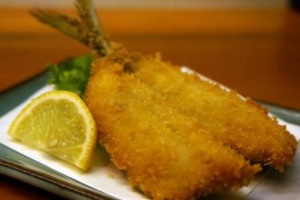
Aji-furai
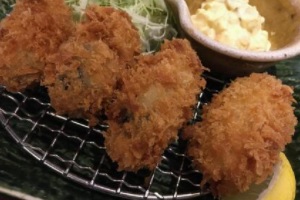
Kaki-furai
Kara-age
"Kara" means "old China", and "age" means" fried cooking".
It is thought that the soldiers back from China after losing in the World War II spread in Japan.
In short, it is the fried dish such as fried chicken from the foreign country.
Unlike tenpura, after coating only flour, the ingredient is fried in the deep oil.
Most popular kara-age is chicken.
Wheat flour is used for kara-age, but there is the fried dish using potato starch as the flour.
It is the dish named as Tatsuta-age.
Tatsuta-age is a fried dish originated in Japan.
Chicken, pork, tuna and the some other fish are the popular ingredients for Tatsuta-age.
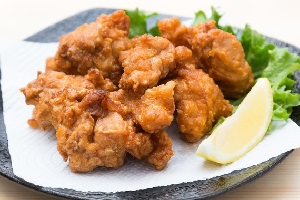
Kara-age of Chicken
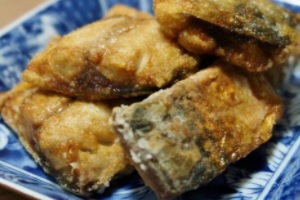
Tatsuta-age of Saba (Mackerel)

